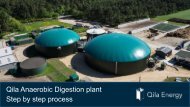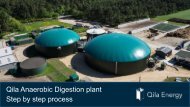You also want an ePaper? Increase the reach of your titles
YUMPU automatically turns print PDFs into web optimized ePapers that Google loves.
3 - The liquid feedstock is moved to the Turbo<br />
Tank<br />
The liquid feedstock suspension is pumped into the Turbo Tank, via the pump room. The first stage of the AD process, Hydrolysis,<br />
occurs in this tank as the matter is broken down <strong>by</strong> the bacteria. The tank is maintained at 50 -55 °C using hot water circulated in steel<br />
coils around the inner circumference of the tank. The water is heated to temperature <strong>by</strong> harnessing the heat produced in the<br />
Combined Heat and Power Engine (CHP) as it burns some of the biogas that is produced on site.<br />
The feedstock in the Turbo Tank is broken down <strong>by</strong> the microorganisms in about 2–3 days. During the hydrolysis phase, the gas that is<br />
produced, contains a high percentage of Carbon dioxide.<br />
The tank is made of concrete which is cast in-situ, this method provides a stronger more durable tanks than those constructed from<br />
concrete panels or stainless steel, and therefore offers a more robust design. The tank is then insulated to retain the heat and covered<br />
with aluminium cladding. This tank has a flat gas-tight concrete roof and the net volume of the tank is 1,407m 3 .<br />
The Qila design uses three BG500 Paul Michl mixers in the turbo tank. These high quality mixers have a 5.75m long shaft and 840mm<br />
propeller and are designed to prevent the development of settled and floating layers in the tank. The mixers mounted at different<br />
heights, which enable mixing at all levels of the tank. This ensures a homogenised substrate and good circulation of the liquid thus<br />
maximising gas production. Efficient mixing, which is controlled via the control panel, avoids solidification and stratification of the<br />
substrate in the tank.<br />
The BG500 offers a powerful mixing technology, but with low-noise transmission <strong>by</strong> means of a toothed geared belt drive. The<br />
agitator mounting has anti-vibration bearings and the drive shaft has multiple ball bearings running in an oil bath. It offers a user<br />
friendly hydraulic adjustment system. The mixers gear boxes are mounted externally to enable access for maintenance.<br />
The movement of the liquid feedstock and substrate between the various tanks on the plant is via the pump room where the lobe<br />
pumps and controls are located. If the Turbo tank is unavailable, for example down for maintenance, there is an option to <strong>by</strong>pass the<br />
tank and move any liquid feedstock directly to the main digester.





